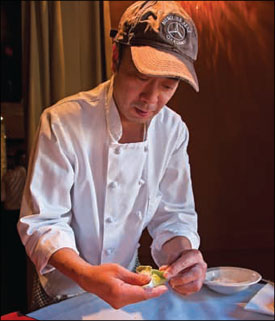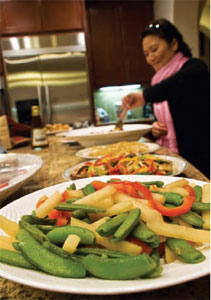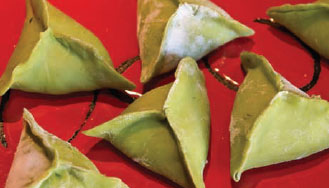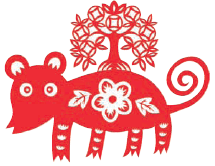|
 By Carol M. Newman By Carol M. Newman
Photography by Lory
Hawley
Tri Valley Magazine,
January/February 2008
Issue
Jennifer Yu, owner of Uncle Yu’s
restaurants in the Tri Valley, is looking forward to unpacking
her family’s 100-year Ching Dynasty dishware and using it to
serve her New Year’s feast. At her Lafayette home, Jennifer,
who was born in Hong Kong, and her husband, Daniel, from
Szechuan and raised in Taiwan, will ring in The Year of The
Rat, which begins Feb. 7, by passing out red Lai-See envelopes
filled with “lucky money” to their children.
In the kitchen of Amy Liu’s Pleasanton home, the entire
family prepares the New Year’s meal. Liu, a sociologist who
hails from Hunan and serves on the board of the
Pleasnton-based Chinese American Cooperation Council’s Chinese
School(CACC), has at least 10 dishes on her menu. They include
her husband’s favorite, mala zi ji, a spicy stir fry of
chicken cubes, hot peppercorns, capsicum, vinegar and Shou
shing wine. In Chinese folklore, it’s said that if you haven’t
eaten mala zi ji, you haven’t experienced Hunan Cuisine.
All around the Tri Valley, old New Year’s customs are going
to be observed and new ones will be born.
Yi Fang, a volunteer teacher with CACC’s enrichment school
at Amador Valley High School in Pleasanton, who comes from the
region of Shandong, spends her Sunday mornings leading her
‘troupe’ of young women in a colorful Chinese fan dance. The
synchronized movements symbolize family as country. Just a few
doors down in another classroom, volunteer and fourth degree
blackbelt belt Brett Jackson goes mat to mat with his white
and yellow belt beginners. The pluck of the guzheng, a
traditional Chinese string instrument, ricochets through the
corridors as dozens of students anxiously rehearse. In a few
short weeks, these students, some as young as four, will
perform on stage for the public at the much anticipated annual
CACC New Year’s show at Amador Valley High School. Although
2008’s Year of the Rat officially commences Feb.7 and wraps up
15 days later, CACC’s Chinese New Year celebration gets
started a little later on Sunday Feb. 17.
The all-day performance, that also includes professional
Chinese dancers, draws thousands of Chinese-Americans from
around the Tri Valley, many of whom feel a kinship with the
carnival-like atmosphere of bright lanterns, Chinese
calligraphy and traditional New Year’s decorations.
This is the time of year when the Tri Valley’s burgeoning
Chinese community prepares for their most important holiday,
the Chinese New Year. Families and friends gather to feast on
dozens of dishes, including one of most important, jiaozi,
boiled dumplings typically stuffed with pork and shrimp. A
staple of New Year’s celebrations, dumplings signify a
long-lost good wish, and are considered a propitious food
because they resemble tael, an ancient form of Chinese
currency. The two big new Asian stores catering to the growing
community, Le Asia Supermarket in San Ramon and 99 Ranch
Market in Dublin, are stocking up for the celebrations.
 Today’s China is a synthesis of
nationalities, and its cuisine is just as complex, varying
from region to region. Ten different cuisines best illustrate
those differences. Sichuan and Guangdong (Cantonese/Hong Kong
style) are most commonly known to Westerners. The former is
popular for its spicy flavor profiles, the latter coaxes with
its mild essences. The other cuisines, less familiar in
America, are Jiangsu, Zhejiang, Hunan, Fujian, Dongbei,
Mandarin, Shandong and Anhui, but all are incorporated into
traditional New Year’s feasts. Today’s China is a synthesis of
nationalities, and its cuisine is just as complex, varying
from region to region. Ten different cuisines best illustrate
those differences. Sichuan and Guangdong (Cantonese/Hong Kong
style) are most commonly known to Westerners. The former is
popular for its spicy flavor profiles, the latter coaxes with
its mild essences. The other cuisines, less familiar in
America, are Jiangsu, Zhejiang, Hunan, Fujian, Dongbei,
Mandarin, Shandong and Anhui, but all are incorporated into
traditional New Year’s feasts.
“New Year’s is like what Thanksgiving is to America,” says
Stanley Kueng, manager of Yang’s restaurant in SanRamon. “It’s
as much about the food as it is a familyreunion.”
The CACC is the largest community group in the area and
participation in the February New Year’s program is strong.
“This year, we will have at least 10 different families making
jiaozi and other dishes,” says Ellen Lui, one of the event
organizers and a CACC board member. Families are as diverse as
the foods they will prepare, representing northern and
southern China, Hong Kong, Taiwan, Singapore, Malaysia, and
America, too. For guzheng teacher, YiFang, the highlight of
the festival is the Shandong steamed buns stuffed with minced
pork or duck.
Lui hopes the significance food plays in the festivities
will draw a more diverse crowd to the CACC celebration.
“Everyone’s welcome,” she emphasizes.
The CACC isn’t the only host of Year of The Rat
celebrations in the Tri Valley.
Several Chinese restaurants will host New Year holiday
feasts. Uncle Yu’s in Livermore is planning its first
celebration. At Willow Tree in Dublin, owner Phillip Chin
says, “It’s a big year for us. 2008 marks our restaurant’s
30-year anniversary.” Each year the restaurant is filled with
local families for the celebration of Dim Sum, which include
har gow, which are shrimp dumplings, and other dishes like the
signature Peking Duck, which is air blown for 10 hours to
separate the skin from the meat, then roasted until crispy and
served with sweet plum sauce, shredded scallions and
steamedbuns. At Tri Valley Seafood in Pleasanton, diners will
feast on Dim Sum like char siu bao, which are barbecue pork
buns, and salt and pepper shrimp served in their shells. But
the real event is the seafood, served fresh from the
restaurant’s own fish tanks. 
Uncle Yu’s chef Peter Tang warms up for the Chinese New
Year’s by preparing a bevy of dumplings year round. He chops
chicken, prawns and mushrooms before stuffing them inside
verdant green wrappers. His Cantonese Steamed Spinach
Dumplings are fastened with a neat trifold, steamed and (going
against Cantonese tradition) then lightly pan fried. Shanghai
Little Dragon Pao, typical of Northern Shanghai, are filled
with a mixture of chicken broth, pork, and green onions. Tang
expertly pinches off the dough, and the wrappers seal ever
more while steaming. Cut into one of these unsweetened juicy
buns and a cloud of fragrant chicken broth spills forth. Chef
Tang, a Shanghai native, adds his own signature, sprinkling
them with sesame seeds. He also makes Szechuan won-tons for
the holiday, filling them with boiled pork and shrimp, the
flavors punched up with a sweet sauce and an entourage of
crunchy sautéed vegetables.
At Yang’s in San Ramon, Taiwanese chef David Yang
specializes in Mandarin-style wok cooking. His menu blends
traditional Chinese offerings with more modern dishes. Crispy
Sea Bass Roll, Coconut Curry Chicken and Basil Eggplant are
popular during the Chinese New Year. Manager Stanley Kueng,
who was born and raised in Hong Kong, looks forward to his
favorite holiday dishes like Nian Gao, which are sweet
glutinous rice cakes. Whole chickens and fish, “head, tails,
feet—everything intact” also make an appearance at the New
Year table. “Serving the entire chicken or fish reminds us of
how prosperous we are,” Kueng says.
According to tradition, the celebration begins on New
Year’s Eve with dinner hosted at the eldest family member’s
home, considered the most important annual family tradition.
Amy Liu’s in-laws come from different corners of the
Chinese food landscape. While her mother-in-law’s roots are
firmly planted in Tianjing, near Bejing, her father-in-law
comes from southern China, where the Chinese New Year’s foods
reflect the Guangdong (Cantonese) cultures. Like Keung, Liu’s
family roasts a whole fish for prosperity’s sake. Dishes
representing the families’ multiple cultures fill the table.
From Guangdong there’s roasted piglet, roasted duck, and stir
fried vegetables. From Tianjing, there is seafood soup and
roasted whole chicken that symbolize good luck and roasted
pork with egg, symbolic of good fortune. “But I do miss my
mother’s special steamed fishballs, made with chopped fish and
rolled with egg and flour,” he says, adding that they
represent reunion.
At the new Le Asian Supermarket in San Ramon, families who
cook on the holiday will find all they are looking for inside
this mammoth 50,000 square footstore. “Families can buy dry
seafood, dry scallops,abalone, shark fin and fat choy (thin
strands of blackmoss resembling vermicelli noodles used as a
veg-etable), says owner Paul Lee. “We have everything peo-ple
will need to have good luck in the New Year.”
Exchanging tokens of good luck is a common practice.
Jennifer Yu decorates her home in red and gold, the symbols of
happiness and wealth. Fruits like pomegranates are showcased
as well, their seeds a symbol of fertility. “A pomegranate
ripe in seeds represents a large family clan. Pineapple,
bananas, tangerines all keep the good luck coming,” she says.
In addition to fruit, candy,and nuts, including packages of
licorice-prepared watermelon seeds, pistachios, coconut and
lotus seeds, are displayed in an octagonal ‘harmony box,’ each
piece enhancing one’s chances of good fortune for the coming
year. 
As Chinese families juggle traditions with contemporary
culture, the celebrations of the Chinese New Year holiday are
evolving. In the United States, traditional 15 day fetes are
cut short and much of the party occurs the first few days of
the New Year. Chef Peter Tang and his wife celebrate quietly
by themselves by cooking dishes like braised whole fish and
drunken chicken. Sometimes, they trek to San Francisco’s
Mayflower Seafood Restaurant in the Richmond District for
authentic Cantonese seafood. Nick Liang, Uncle Yu’s sommelier,
was born in Canton, China, a port city near the South China
Sea. He fondly recalls the fried coconut, peanut and sugar
dumplings of his youth, so sweet they “tasted like candy.”
Like many Chinese families, Liang’s relatives are spread out
around the world so he celebrates, instead, with his
restaurant family, pouring his favorite Champagnes, Alsatian
wines and Burgundys. “Today, anything goes,” Liang says.

|

